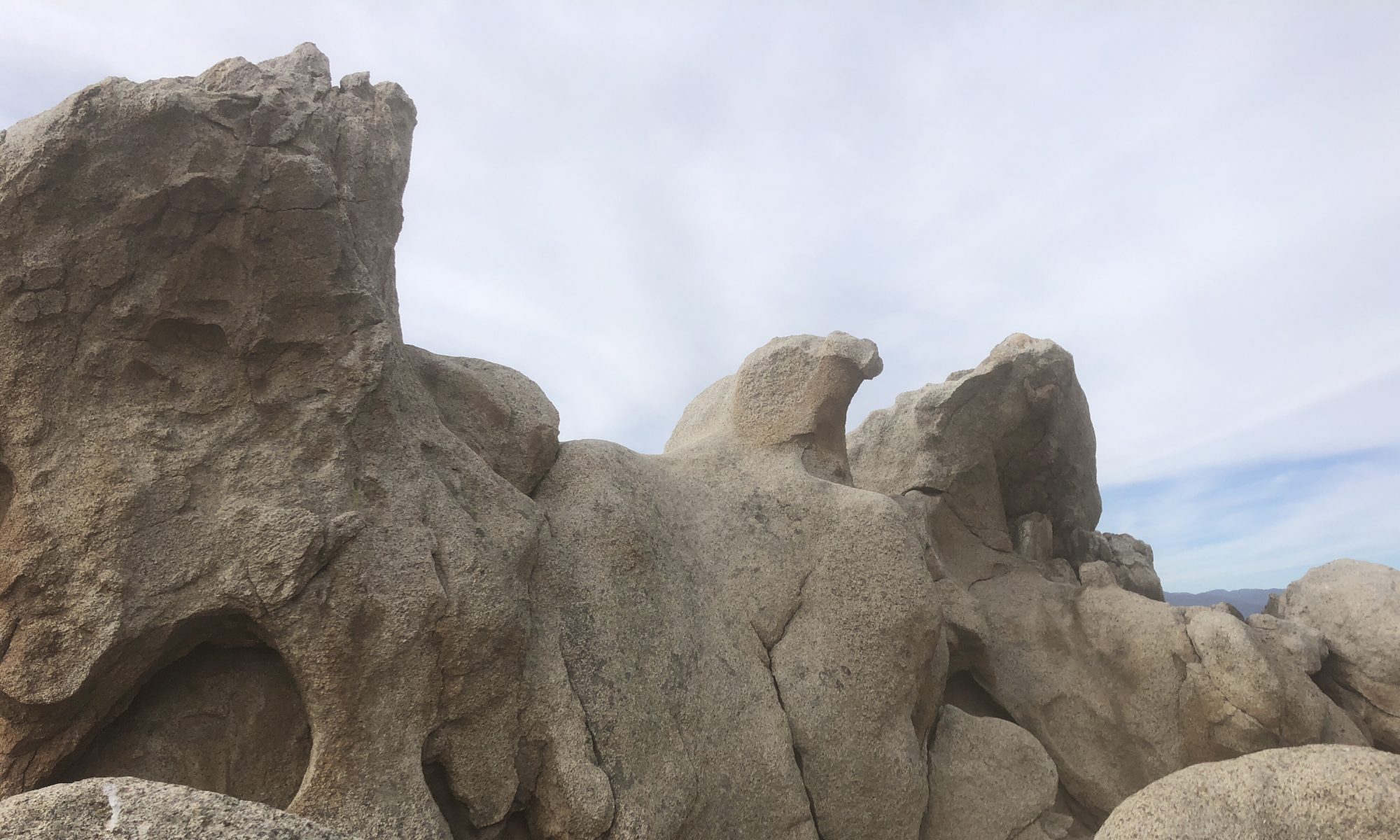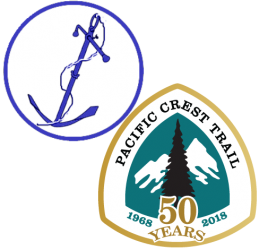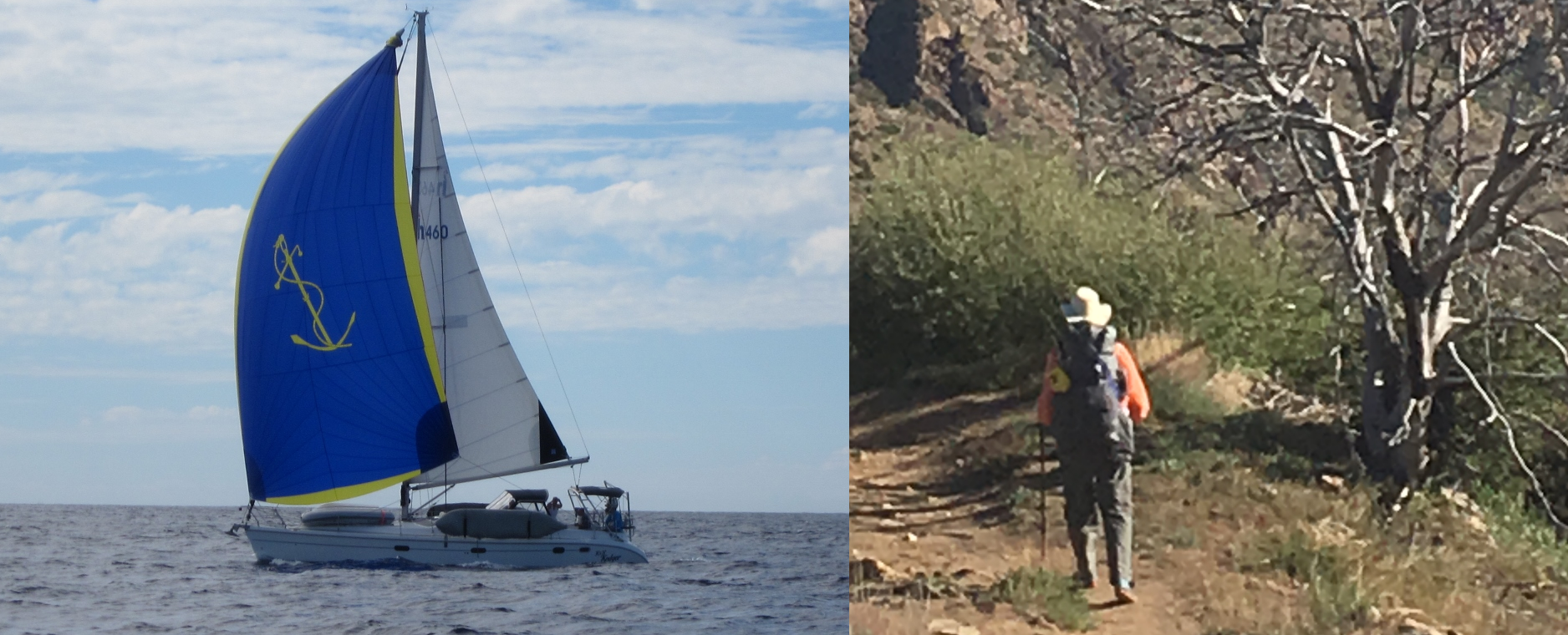Dateline: Vista, CA (20180614)
Although I’ve been a sailor since I was 13 and a backpacker since I was around 20, it’s only when I started planning this trip to hike the Pacific Crest Trail that I’ve realized the strong similarities between these two activities. There are some differences, but many are differences only in magnitude, not requirements. Are they truly the same? You be the judge.
The Obvious Differences
Granted, there are a few obvious differences. For example, you spend a lot more time sitting than walking on a sailboat. And, you don’t have to put everything you own on your body to move it from anchorage to anchorage, although you do bring it with you. On a sailboat, you get to use the wind and your engine to move around. When hiking, there’s usually only your feet. There’s one more obvious difference. I’ve yet to experience motion sickness while hiking. I did that plenty of times while one the sailboat. However, after you move beyond these differences, there’s a lot of similarities.
Comfort Zones
Backpacking or cruising. Right from your very first action. Whether it is the first time you cast off the dock lines or take your first step on the trail, you are leaving your comfort zones. It’s ok. Go ahead. Expand your life. Sure. In either case, you might die. However, you could also get hit by a drunk driver while you’re just crossing the street to get to no place special. THAT would be truly tragic.
Resource Management
Sailing and backpacking both involve a lot of resource management. In each case, no matter what resource concerns you, you have a limited amount that you carry with you and limited access to get more of it. A few examples,…
Water!
Access to clean water is the highest and first priority. While sailing, we were able to collect a lot of rain water. While hiking, I’m also able to collect a lot of rain water. It just comes from the streams or springs. On the boat, we would carry as much water as we could, up to 200 gallons. When hiking, I determine how many liters to carry by considering miles, elevation gain, and environment (dry desert vs. mountains with flowing streams).
Food
Provisioning happens on a different scale. For sailing, we’d often provision for 30 days. For hiking, I’m typically provisioning for 4 to 7-ish days. Provisioning quantities are different, but the process is the same and begins with the question, “When can I reasonably expect to resupply again?”
Fuel
For the boat, it was diesel & propane. For the trail, it’s compressed gas for cooking (although many hikers have given up cooking in favor of cold food and a lighter pack). In both cases, if we ran out of fuel, we still had options like eating cold food.
Replacement Items
Whether it’s a replacement part for the engine or new shoes, there are always items that you end up needing when ‘underway’, but for which you have no immediate access. The internet has made solving that problem much easier for both cruisers and hikers. I’ve ordered engine parts and had them delivered to the next foreign port and I’ve seen hikers, from the trail, order everything from shoes to ground pads to be delivered at the next town.
Underway
When you moving, you’re faced with similar challenges and considerations.
HYOH and Sail your own boat
Sailors and hikers both learn very quickly that they must hike their own hike and sail their own boat… or suffer the consequences. Speaking from personal experience, failing to sail your own boat might lead to running aground, as I did in the San Blas Islands when I followed a boat that i thought was about the same size as mine across a sand bar. Unfortunately, it was a smaller boat with less draft. He crossed the bar fine. I did not!
Hikers learn that attempting to keep up with faster hikers leads to injuries, some as simple as blisters or others more debilitating like knee pains or shin splints. Bottom line: Listen to your body and hike your own hike.
Risky Crossings
Just don’t. This is a sailing lesson applied to hiking. For sailing, it is crossing seas like the Tehuantepec in southern Mexico or rounding Cape Hatteras on the east coast of North Carolina. Bad conditions mean bad crossings. Avoid them. For hiking, it is the river crossings in the Sierras.
Just like when sailing, you have options when hiking. How far is it to the river sources? Can you find the smaller tributaries and cross there? Or wait. Early mornings have lower flow. Just like sailing, no schedule makes a world of difference regarding safety.
The best seamanship doesn’t happen at sea. It happens before ever leaving the dock. In the case of backpacking, it happens each day before ever breaking camp.
Operational Urgencies
Both sailing and hiking present dynamic conditions that require immediate attention, or have highly undesirable consequences. When the wind begins to build while sailing, you learn over time that the moment to furl the sails is that instant when you first think, “I wonder if I should furl the sails.” For hiking, it’s that ‘hotspot’ in your shoes. The first moment you think, “That spot on my foot feels a little hot, I wonder if I should check it?” STOP! It’s time to check your foot … or face the ugly (and I do mean UGLY) consequences. I am still in the process of learning that, “I wonder if I should put my fly on my tent tonight” really means, “Damn it. Stop being lazy and put your fly on your tent!”
Physical Constraint Details
Even details have similarities. For example, when sailing a big sailboat on the Intercoastal Waterway, the ICW, it’s best to travel with high tides to keep from running aground. However, you want low water to get your mast under the bridges. Basically, conflicting physical conditions result in the best travel. On the PCT in the Sierras, as the snow melts, you want to do your stream crossings at low water, which happens in the morning following the night freeze. Streams are always at the lowest point in the valley. Then, of course, you also want to travel over the mountain passes, the highest points, in the morning, while the snow is still frozen before turning to dangerous slush during the afternoon thaws. So, you basically want to position yourself to be at the highest and lowest points at the same moment each day. Ugh!
Anchorages and Campsites
Protocol when stopping is identical for sailors and hikers. First come, first serve. If you’re neighbor thinks you’re too close, last to arrive has to move. Oh, and most important, if you don’t like your neighbors, you can pick your house up in the morning and move it to a new location.
Personal Hygiene
Need a Shower?
Shower daily when working? Not so much when on the boat or hiking. On the boat, it was a common occurrence to go for days without showering, but it was also easy to step off the back for a swim followed by a quick fresh water rinse. So far, hiking through the desert has only provided three opportunities for a good rinse in nature. Showers have waited for town visits. I’ll be in the Sierras soon. While there will be more opportunities to rinse my feet, the thought of whole body dips in 32.1ºF water (0.1ºC) doesn’t appeal to me much at the moment. We’ll see.
Restroom?
The boat had heads. The trail? Well, let’s just say I’ve placed my trowel in a handy location in my pack. In both cases, toilet paper is being ‘wrapped up into pretty packages’ to be disposed of properly at another location. We found wet-wipes and hand-sanitizers useful in both environments.
Finance
Money matters are similar, just on a difference scale.
The Size of Money
Small dollars vs. big dollars – The level of spending is highly variable and pretty much up to you. Gear, food, lodging, transportation. Pick and choose where to spend your bucks. It’s completely personal.
Cash Flow – When
As a business guy, I found this interesting. Both sailing and hiking have a substantial amount of the cost that’s best spent up-front. Spending on appropriate gear before leaving improves the quality of life when you actually start moving.
Once you’re underway or at-anchor, walking or at camp, you spend next to nothing. Now, in both cases, you occasionally have the opportunity to pull into a marina or walk into a hostel, hotel, or resort. Things you really appreciate once you get there include protection from the weather and plenty of water. Of course, days spent there are on the higher end of your costs. Anchoring and camping in your tent typically mean $0- fees. However, it’s a personal choice and you can make it when the opportunity presents itself.
Technology
Sailing and backpacking have both benefited significantly by advances in technology. Sometimes it’s the same technology that’s crossed over to the other application.
Electronics: Planning, weather, navigation, and communication
The similarities in technology are astounding. With the exception of radar and radios (Ham/SSB and VHF) that we had on the boat, I can pretty much match up my planning, weather, navigation, and communication technologies between what’s available to me hiking and what we used when sailing.
I’m carrying a Garmin inReach satellite device. It’s my EPIRB for the trail should I need to send an SOS or request Search-and-Rescue. Plus, it adds satellite text messaging and location reporting to keep family and friends informed.
GPS kept us from getting lost on the boat and it keeps me from getting lost on the trail. While both sailing and hiking, WiFi … sometimes you have it., usually in town Sometimes you don’t. As for cellular – See WiFi. My cellular phone works … sometimes, … just like on the boat.
Various apps are providing weather and navigation information, very similar (or identical) to what I was using on the boat.
Beyond Electronics
Technology advances developed for sailing have also advanced hiking. Many applications in high performance sailing share the same characteristics of ultralight backpacking. The similarities have led to things like “Dyneema Composite Fabrics” (AKA, DCF or Cuben Fiber Fabric), originally developed for racing sails, to be used to produce a variety of backpacking items from tents to bear bags.
Other products, like Columbia’s PFG (Performance Fishing Gear) shirts are great for sailing, but they are also a popular choice among hikers because they a) protect from the sun and wind, b) are light weight, and c) dry quickly. When the opportunity presents itself, I use a little desert trick we picked up when rafting the Colorado River. This is a great shirt to dunk in the water and put it right back on. You’ll stay cool for quite a while yet still be comfortable wearing it.
There is other clothing tech I’ve learned about while backpacking that I wished i’d known about when sailing in the mosquito infested waters for Central America. I’m wearing ExOfficio’s BugsAway pants and shirts into the Sierras. Using an odorless treatment applied to the fabric, they promise to keep the bugs away through 70 washes. “Ants, flies, chiggers, midges, and ticks don’t like it, and neither do mosquitoes, which can transmit insect-borne diseases such as Zika, Chikungunya, Dengue, and West Nile viruses.” I’ll let you know how it works out.
People
Fear of others
Both sailors and hikers start with an excessive fear of others. On the PCT, it starts with an unwarranted fear of Illegal Immigrants. I never saw any illegal immigrants down by the border, nor did I hear of anyone seeing or hearing any. Now, we saw and heard a LOT of Border Patrol, but not aliens.
And then, there is always the fear of legal residents. Bad people exist. However, we met very, very few while sailing. And as far as hiking goes, so far, the pendulum swings so far the other direction that it is exceptionally noteworthy. There are many, many people going out of their way to help people on the PCT. Whether it’s keeping a critical cache stocked with life giving water, picking up a trail hitch hiker to give them a ride into town, or simply an acknowledging nod and smile, people along the PCT have been wonderful.
Meeting People
Similar. In both cases, you learn to say good-bye to the nicest people. Maybe you meet them again, and it’s always great when you do.
Meeting Up with People
Sailing and hiking take you to some amazing places. Friends like to see these places and sometimes they can come to meet you. However, hiking, just like sailing has the same ‘meet-up’ challenge. It’s easy to name a place or time well in advance. However, it is very difficult and risky to do both!
Unique Language
Sailors and hikers have their own languages and terms. For examples, Vitamin B (AKA Beer) and Trading for Coconuts (as it’s illegal to sale anything over the radio and in some countries without paying appropriate import fees).
Both sailors and hikers have an adjusted ‘midnight’. Cruisers’ Midnight (around 9pm) = Hiker’s Midnight (as early as 7pm, but normally also around 9pm).
Hiker’s get trail names. Sailor’s answer to their boat name.
Perceived Social Status
Sailing and hiking both level the playing field when it comes to social status. As a sailor, I cared not one iota for a person’s status in the unnatural (man made) world. Once on the sea, we were all facing the same challenges mother nature, and local governments, threw in our paths. All participants earned and deserve solid respect.
“The trail taught me to be conscious of privilege. This one especially I hope to keep top of mind as I move forward. The trail is just the trail and treats everyone the same. It matters not who you are, where you come from, how much you have or don’t have, what you have accomplished, you still have to climb the same hill as everyone else. When your life experience suggests it should be otherwise, trouble is not far behind. Awareness leads to insight.” – From Walking My Way Home – The Math After
Hearsay
It’s interesting how much ‘information’ is offered with the best of intentions and the fewest of facts when sailing and hiking. Remember the elementary school game of ‘Telephone’? Messages change materially as they are passed on from person to person. You learn pretty soon to ask, “Have you been there?”
You also learn to trust information based on the source providing the insight. Here’s a perspective from Jessica Mills (AKA Dixie). “I know Perk and I know his hiking style. … Other Thru-Hikers aren’t credible.” (From PCT 2017 Episode 12: “A Whole New Trail.”)
We did EXACTLY the same thing while cruising when judging information being provided by other sailors. We understood the meaning of the words used in the descriptions provided by sailors we knew well. Words from sailors we didn’t know were MUCH less useful.
Bugs
I mentioned bugs in the tech clothing, but a little more detail is warranted. Both sailing and hiking are similar when it comes to mosquitoes. However, hiking has a LOT more bugs than I ever saw sailing. Bees. Ants. Spiders. Flies. Gnats. Ticks. Scorpions. Not to mention lizards and snakes. There are plenty of crawling and flying things to encounter while hiking. So, that IS different from sailing where we rarely saw bugs. Of course, we were VERY careful with every piece of fruit and other items we might bring aboard the boat to ensure that we would have few bug encounters.
Time Awareness
One consequence that I really loved while sailing, and now enjoy while hiking, is completely losing track of the date, day, month, and maybe soon, years. You’re very aware of the time of day, especially near sunrise and sunset. However, you soon become completely unaware of larger measures of time. Day of the week? No idea. Month? Well, I think I know, but mostly because it’s not snowing yet.
Post Adventure
Things I expect to be the same after hiking as they were after sailing.
- Cars move way too fast!
- Post Trail Depression vs. Post Sailing Depression: I’ll have to wait to comment on this topic, as I’m still ‘on the trail’, even though I’m sitting at home as I write this comment. I can speak to sailing. Life seems very static after moving routinely. I suspect life will feel static again when I get off the trail.
- Relating to others: It will be challenging to have a conversation without bringing up the trail or sailing.
Things I expect to be very different:
- If I decide to sale my hiking gear, while waiting for the deal to close, the ‘dock’ fees for my backpacking gear will be a lot lower than they were for the boat.
Judgement
In summary, maybe they are so similar because they both cause you to investigate, “What are the minimum requirements you need to sustain life?” And you get plenty of time to contemplate, “What are you doing with the life you’re sustaining?” There’s great clarity in those assessments.
Do the obvious differences outweigh the similarities? In the big scheme of things, is there really a difference? You make the call.
Fair winds



Nice contrast and compare. When your hiking adventure is really done, a post about your gear and what worked and didn’t would be interesting, especially the electronic tech.